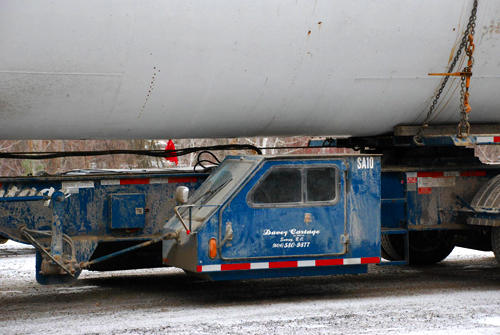A transport company spent more than two months planning the move of six extremely large pressurized tanks from Genelle, B.C. to the U.S. border at Porthill, Idaho. It’s only a 148-kilometre drive, but it wasn’t so simple with each load weighing 91 tonnes!
Mining company Teck Cominco had sold the cylindrical vessels and was shipping them to a buyer in North Dakota, for use in a natural gas plant. Davey Cartage Ltd., a Surrey, B.C.-based hauler of bridge girders and other oversize and overweight loads, took on the job.
The giant tanks turned heads as they travelled from Genelle, via Highways 22, 22A 3B and 3, and over Kootenay Pass to Highway 21. These were the largest and heaviest loads ever hauled between these locations.
Developing the transportation configuration wasn’t easy. Commercial Vehicle Safety Enforcement (CVSE), Davey’s engineering staff and the ministry’s bridge branch worked together on how the tanks and transport could be arranged, double-checking as they went.
To distribute the weight, each tank would ride on two hydraulic platform trailers – a small trailer known as a jeep, and a manned steering dolly. Between the semi truck and the trailers, each vessel was supported by 46 wheels turning around 12 axles. From the front of the tractor to the back of the rear trailer, the load measured 42 metres long – almost the length of an Olympic-size swimming pool. The tanks themselves were 5.18 metres high and 4.27 metres wide.
The steering dolly compartment housed a driver who helped navigate the trailers around corners designed for loads about half the size
How do you steer a load that huge? The answer is a manned-steering dolly with a small compartment equipped with a driver’s seat, large steering wheel, windows, air horn and rear-view mirror. The dolly driver steers the trailer while maintaining radio contact with the pilot car in front of the load, the two pilot cars at the rear and the truck driver. This is how something that enormous can navigate corners designed for vehicles that are (only!) 16 metres long.
The loads crossed over Kootenay Pass, BC’s highest mountain pass (1,775 metres above sea level), in the middle of winter. CVSE staff consulted the ministry’s local snow avalanche employees to advise Davey Cartage of the best time for the move.
CVSE issued a permit with the proviso that Davey Cartage check with local utilities to ensure the loads would not contact any power lines. Approval from the RCMP was also required, and travel was restricted to between midnight and 7 a.m., to avoid traffic.
In addition to the six pilot trucks, there was as a contingent of CVSE escorts. The company positioned sand trucks and a commercial vehicle tow truck at the Salmo-Creston hill, just in case.
The first two tanks await the opening of U.S. customs at the Porthill Crossing on Highway 21, 10 kilometres south of Creston. CVSE staff from Castlegar and Creston oversaw the move.
The ministry’s work with Davey enabled industry to move its business forward, while ensuring public safety and protecting local bridges and road infrastructure. In the end, all six vessels arrived safe and sound, with the first pair leaving Genelle, on Jan. 11, and the last reaching their destination on March 7.
Each year, the ministry issues about 56,000 permits to allow overweight, oversized loads to reach their destinations. It’s one way we keep industry and the economy moving, while providing B.C. with a safe and reliable highway system.



Join the discussion